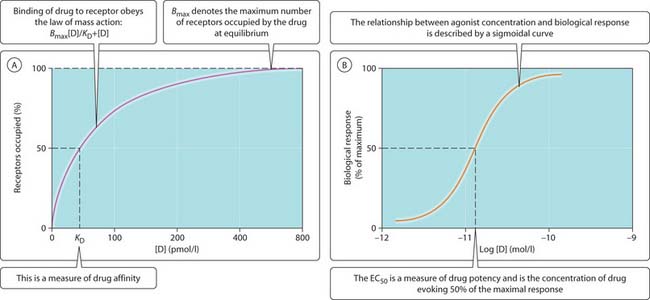2 Drug–receptor interactions
Agonists
The binding of a hormone, neurotransmitter or drug to its receptor is, in most cases, a reversible process that can be described by the law of mass action (Fig. 3.2.1). At equilibrium, the rates of drug–receptor complex association and dissociation are equal. The equilibrium is determined by the affinity of the drug for its receptor and by the drug and receptor concentrations. This can be examined in binding studies in which a drug labelled with a radioisotope is incubated with a homogenate of membranes from tissues or cells. Washing removes any unbound drug and the retained radioactivity (after correction for non-specific binding) most likely reflects binding to the receptor of interest.

Fig. 3.2.1 Relationship of ligand concentration with receptor occupancy (A) and biological response (B).
A number of useful parameters are derived from this relationship (Fig. 3.2.1A). The concentration of drug required to occupy 50% of the total number of receptors available is denoted by KD and is a measure of drug affinity. In general, drugs with high binding affinity have very low KD values (i.e. nanomolar) and, therefore, would be advantageous for the treatment of diseases, since the drug would selectively bind to the desired target but not to other proteins, thus reducing side-effects.
Some agonists are better than others at eliciting a biological response because they are better able to induce a conformational change in the receptor protein (Fig. 3.2.1B). This transition to an activated complex is a prerequisite for a biological response. The ability of an agonist to induce a conformational change in the receptor is its efficacy. Drugs with high efficacy have a greater propensity to induce a conformational change in the receptor than drugs with low efficacy, producing maximum biological response while activating only a fraction of the available receptor pool. In most cases, such drugs are often referred to as full agonists. Agonists with low efficacy, and therefore less able to evoke the full biological response despite occupying all of the available receptors, are termed partial agonists. Note that partial or full agonists will also possess their own particular affinity for a receptor (Fig. 3.2.2). Potency describes the ‘strength’ of a drug and is evaluated as the EC50 (concentrate evoking 50% of maximum response). It is a useful measure of how good a drug is at evoking a response and is dependent on drug affinity and efficacy.
< div class='tao-gold-member'>
Stay updated, free articles. Join our Telegram channel

Full access? Get Clinical Tree






